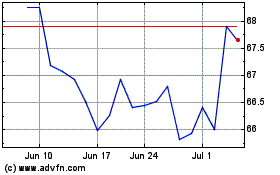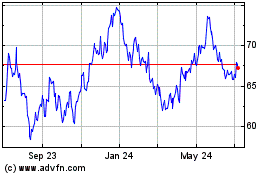By Rhiannon Hoyle
SYDNEY--The dam break at one of BHP Billiton Ltd's joint-owned
mines in Brazil, which has already resulted in two deaths, is one
of the worst accidents in the Anglo-Australian miner's recent
history, and comes as steady improvements in major mining
companies' records on worker fatalities appear to have stalled.
The exact causes of the disaster near the Samarco iron-ore mine,
jointly-owned by BHP and Brazilian miner Vale SA, may not be known
for some time, experts say, as efforts continue in the search for
dozens of people missing in heavy flooding in the area.
Coming as a result of a dam breach, the accident in the
southeastern Minas Gerais state is different from many past mining
accidents, which typically occur down deep mine shafts.
Still, mining majors have seen a rise in fatal accidents in
2015, when most are enacting heavy cost cuts as they battle to
remain profitable amid a downturn in world commodity prices.
Mining companies such as BHP, the world's largest miner by
market value, stress safety is a priority. The company, dual-listed
in the U.K. and Australia, is known for its almost obsessive
approach: Even first-time visitors to its corporate offices in
London and Melbourne are required to watch a safety video before
attending meetings.
BHP, though, recorded five fatalities in its financial year
through June, at operations in Australia, Chile and South Africa,
up from none in the 12 months prior.
BHP's Anglo-Australian peer, Rio Tinto PLC, reported three
deaths in the first eight months of 2015, compared with two in all
of 2014. In the first half of 2015, Anglo American PLC, a
U.K.-listed mining major with substantial operations in South
Africa, suffered five deaths, compared with 6 in total in 2014,
while Glencore PLC, another mining giant, saw eight workers die,
compared with 16 in all of 2014.
The small rise in fatalities has come despite industry efforts
to reduce worker deaths in recent years.
Large, highly-mechanized mines and reduced workforces have aided
a steady fall in accident-frequency rates. Companies have been
willing to share knowledge on safety matters, establishing global
standards. Companies have also made ensuring safety a key measure
in calculating executive bonuses.
Two years ago, BHP said it would close its Perseverance
underground operation, in Western Australia state, over safety
concerns.
In a speech Thursday, Andrew Harding, head of Rio Tinto's
iron-ore division, spoke of the change in focus.
"Twenty years ago, safety was not the priority within Rio
Tinto--indeed the whole resources sector--that it is now," he said.
"Now we start each meeting with a safety share, we de-risk the
workplace, we measure, and we continuously translate mistakes into
learnings to make people safer."
Still, there is a danger mining companies' recent success may
have bred some complacency, warned David Cliff, professor of
occupational health and safety in mining at The University of
Queensland in Australia, in a recent paper.
The pressure on mines to improve productivity and reduce
staffing could "lead to a reversal of the safety culture
improvement through the focus on doing what has to be done rather
than what should be done," Mr. Cliff wrote. "There is a real danger
that the health and safety performance in developed countries will
get worse rather than better."
At BHP, the recent rise in fatal accidents triggered a
three-month review this year, during which it pooled feedback from
employees on the company's safety priorities for the next two
years.
However, the company only reports fatalities at operations it
manages, which is standard industry practice.
In BHP's most recent sustainability report, the company said
that "The health and safety of our people and of the broader
communities in which we operate is central to every aspect of our
business."
Samarco, near the Brazilian city of Mariana, is run
independently from BHP, although it and Vale appoint board members.
A spokesman for BHP said he wasn't yet able to comment on the
company's oversight of Samarco's safety procedures.
For some global miners, safety issues are linked to the
countries where they operate.
Last year, most of the fatalities Glencore suffered took place
in "challenging geographies, which did not feature strong safety
cultures before we took over," it said in its annual sustainability
report.
The company has identified operations in Kazakhstan, the
Democratic Republic of Congo, Ukraine, Zambia and
Bolivia--countries in which it collectively employs more than
70,000 people--as "focus assets" where it is expending the most
effort to reduce work-related deaths. Two years ago, Glencore
implemented a new initiative, called Safework, to encourage its
workers to stop unsafe work practices.
Anglo American's safety Achilles' heel has long been its
platinum-mining operations in South Africa, which accounted for
half of the fatalities it suffered last year. Platinum mining often
takes place deep underground and is labor intensive.
Under Anglo's former chief executive Cynthia Carroll, fatalities
fell by 60% from 2007 to 2012, and have continued to fall under her
successor, Mark Cutifani. The company is now concentrating on
platinum assets that are less deep under ground.
While up-to-date data for the mining industry globally isn't
available, the vast majority of mining accidents take place in
mines outside of the control of mining majors. That includes the
high-profile 2010 rescue of 33 miners trapped in an underground
mine in Chile for 69 days, the longest such entrapment in history.
The mine was run by small Chilean outfit Compañia Minera San
Esteban Primera.
China continues to be beset by fatal mining accidents. Even so,
the number of annual deaths related to coal mining fell under 1,000
last year, according to government data cited by Professor Tim
Wright, a professor at The University of Sheffield in the U.K. As
recently as 2002, nearly 7,000 coal miners died in a single
year.
In the U.S., fatal mining accidents rose to 45 last year, up
from 42 in 2013, according to the U.S. Department of Labor's Mine
Safety and Health Administration. This year, fatal incidents are
tracking behind those levels, with 25 deaths recorded as of Nov.
6.
Alex MacDonald in London contributed to this article.
Write to Rhiannon Hoyle at rhiannon.hoyle@wsj.com
Subscribe to WSJ: http://online.wsj.com?mod=djnwires
(END) Dow Jones Newswires
November 08, 2015 09:49 ET (14:49 GMT)
Copyright (c) 2015 Dow Jones & Company, Inc.
Rio Tinto (NYSE:RIO)
Historical Stock Chart
From Mar 2024 to Apr 2024

Rio Tinto (NYSE:RIO)
Historical Stock Chart
From Apr 2023 to Apr 2024
